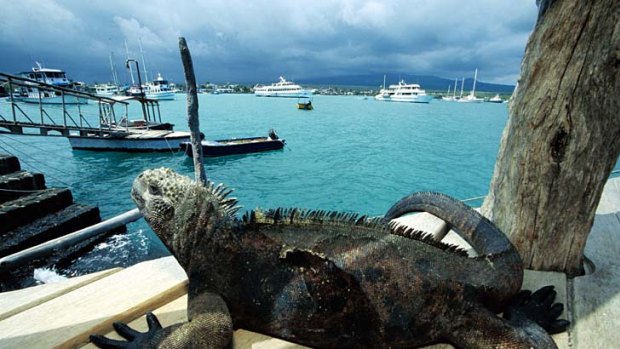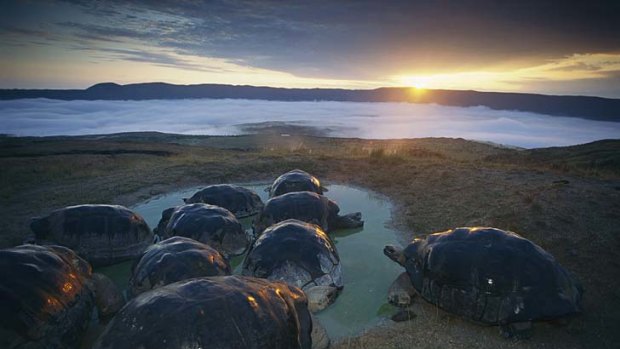
Animal attraction ... a marine iguana rests dockside on Santa Cruz Island.Credit: Getty Images
Kelsey Munro is not immune to the charm of a sea lion or the forces of nature while exploring the teeming archipelago.
Barely 20 minutes after touching down in the Galapagos Islands, we realise we're in a parallel universe. It's not the green volcano or the austere candelabra cactuses, nor the dusty, ramshackle town on the island of San Cristobal. It's the inhabitants. Piles of them snooze in the sun under the children's play equipment. They loll around outside the shops on the beachfront promenade and trespass on moored boats. They burp, scratch and bark like a bunch of old drunks and generally behave as if the humans matter not at all.
The tiny town of Puerto Baquerizo Moreno is overrun with sea lions. They're cute as puppies, though they smell like rotting fish and make noises like retching dogs. You can spot the new tourists in town: they're the ones going gaga over the sea lions. The locals just step around them.

Galapagos tortoises wallow on Isabela.Credit: Getty Images
I have brought with me Charles Darwin's book The Voyage of the Beagle, where in a slim chapter the legendary naturalist writes about his five weeks on the islands of San Cristobal, Floreana, Santiago and Isabela in 1835. His observations of the wildlife provided key clues to his world-changing theory of evolution. I am charmed.
"Listen to this," I call to my boyfriend from the bed of our hotel room on Isabela. "'Seeing every height crowned with its crater, and the boundaries of most of the lava streams still distinct, we are led to believe that within a period, geologically recent, the unbroken ocean was here spread out. Hence ... we seem to be brought somewhat near to that great fact - that mystery of mysteries - the first appearance of new beings on Earth."'
I sigh.
My boyfriend looks around the bathroom door. "Do you have a crush on Darwin?" he asks.
Well, you know. Maybe a little one.
When the charming, gentlemanly Darwin was here - studying, riding and even eating the tortoises - the islands were a base for whalers, sailors and eccentric foreign settlers. They were a strategic base for American forces in the Pacific during both world wars. Mainlanders ran merciless penal colonies on the islands, on and off, for more than a century. Then, in 1959, the fragility and uniqueness of the 13 major islands of the Galapagos were recognised by its designation as a national park by the Ecuadorian government.
Today, about 30,000 people live in the Galapagos, mostly working in tourism. Visitor numbers are restricted. Drinking water and food have to be flown or shipped in but there is a push to make the Galapagos and its tourism industry more sustainable.
We have chosen an eight-day land-based tour that will take us to four islands: San Cristobal, Floreana, Isabela and Santa Cruz. Restrictions by the park authorities and practical transport concerns mean independent tourism is not a viable option. Most tourists choose live-aboard cruises, which make sense because the boats can cover distances at night. But the cheaper boat tours don't have a great reputation and the land tours ensure more tourist dollars flow into the local economy.
The hotels we stay in are basic but clean, with hot showers, and almost all have free Wi-Fi, to our surprise. We're happy to be able to stretch our sea legs and sleep on solid ground. And, as it turns out, it's a good week to be on dry land.
Our trip begins on San Cristobal, where sea lions rule. You need to steer clear of the big bulls, which can be dangerously territorial, but the rest seem happy to pose for close-ups. The island is temporarily green and lush at the end of the wet season.
A day trip takes us to some of the most spectacular snorkelling imaginable, at Kicker Rock, a steep, split shard jutting out of the ocean. I plunge into the deep blue and swim awhile alongside a stately sea turtle that glides like an elegant airship in underwater flight. I scatter a thick school of tiny fish gleaming like mercury.
A steep coral wall stretches down and away, covered with pink and red tube coral and anemones, brightly coloured fish nipping at the undersea cliff. It's like something in a dream.
The next day we make the four-hour crossing to Floreana - it would be faster in bigger boats. Seasickness tablets help us through an uncomfortable journey. Hiking inland, we come across a low wall of volcanic stones that hide something ancient. It has the head of ET; the neck of a snake; the leathery, pigeon-toed limbs of an elephant; a smooth giant dome of shell. The tortoise heaves its armchair-size body over to some fresh leaves, glaring at us. This one is kept as a pet but elsewhere we find them roaming wild. Floreana's tortoise species are extinct, wiped out by sailors who took them for meat after it was discovered they could survive a year without food or water.
On Pinta Island, only one survived this slaughter. Lonesome George has been living out his long days with a couple of lady friends (of a different species) at the Charles Darwin Research Centre on Santa Cruz since 1971.
From Floreana, escorted by dolphins, we cross to Isabela where our guide, Carlos, is from. In the bay, sea lions bask on moored boats. A stunning white-sand beach is dotted with iguanas and brilliant-orange crabs. In Puerto Villamil, a dusty but pleasant town, there are no souvenir shops selling tourist tat, no hustlers, no touts. Not even many tourists. We eat fresh prawns with rice and fried plantains and drink beer. Life is grand.
The next day we walk to the Wall of Tears, built by convicts in the 1950s and '60s. At a high spot we can see black lava fields and white beaches fringing the gentle green slope of the volcano and frigate birds wheel above us, their ballooned red throats catching the sun.
After lunch we take a short boat ride to a moonscape of black volcanic rocks, jagged and mean and spotted with lichen. It looks like the surface of some hostile planet. Then our eyes adjust and suddenly iguanas are everywhere. Hundreds, possibly thousands, of the nesting lizards blend so well with the rocks you could tread on one before you saw it. It's unbelievable. A frigate bird swoops and steals an iguana egg.
We watch a pool of whitetip reef sharks passing the daylight hours in a sheltered cove. Then we go snorkelling nearby. This seems to be a bad idea but Carlos promises these guys won't bite - not us, anyway. We jump in and it's like swimming in an aquarium. We see a vast ray the size of a kitchen table, a giant turtle, masses of blue surgeon fish - then, triggering a bolt of adrenalin, three whitetip reef sharks about as big as me. It is exhilarating. That night, we eat fresh fish and rice and talk incessantly about what we've seen.
The next morning we're woken at dawn by Carlos at our window. "There's been a tsunami in Japan," he says. "We have to evacuate." Details are sketchy. People are panic-buying food and water in the town. We eat breakfast while Carlos takes a phone call in Spanish. He hangs up and says, "Run!" Funny guy. Impact is expected about 6pm, he says, so our trip to Santa Cruz is postponed. We're heading instead to Isabela's highlands, to Sierra Negra, one of the world's largest active volcanoes. Just the day before we completed a spectacular 16-kilometre hike around its 10-kilometre-wide crater. It last erupted six years ago, sending rivers of molten basalt down its northern face.
We are fleeing a tsunami that followed an earthquake, to wait on the slopes of a massive active volcano. I really should have read my horoscope this week.
Two hours later our group of 13 is high on a grassy campsite with about 60 people, mostly older German cruise-ship passengers. We wait, with no idea we'll be here for 14 tense hours as the disaster in Japan unfolds and its side effects ripple across the Pacific.
Carlos gets news of two other earthquakes, in Chile and Cuba. "Maybe it really is the apocalypse," my boyfriend says. Hours later there's news a wave has hit Hawaii.
Restless, my boyfriend and I decide to walk. In a clearing on the trail we find a friendly man with a yellow van, who communicates using hand gestures that nothing has happened yet.
We stand with him, looking out towards the sea, and share our binoculars. I catch some words on his radio: "incendio" (fire), "mille muerto" (1000 dead). It sounds bad.
Back at the campsite after sunset, an announcement is blaring through the dark. Carlos translates: we must wait for word from the President that it is safe to go back to town. The President is 1200 kilometres away in Quito. Carlos shrugs. We wait.
Two hours later, no one has eaten dinner. Nerves are fraying. The Germans get some bad news - they can't go back to their boat tonight. They snipe at our group for talking while their guide speaks. Unprovoked, a man yells at my boyfriend. We wait another couple of hours, grimly. No one is allowed to leave.
Suddenly there is movement. Carlos is getting us out of here on the quiet. I could hug him.
"We go this way," Carlos whispers, pointing away from the Germans. "Like ninjas."
The military is still blocking the exit when we reach the road but Carlos finds our bus and we pile in with his neighbours, their children and their pets. An hour later we finally roll down the hill and as we pass the campsite, we grin and wave in schadenfreude at our grumpy fellow travellers, still stuck there.
Next morning we hear news of what has happened in Japan and we count our blessings. We take a small boat to Santa Cruz, devouring thick slabs of fresh cheese on sweet brioche procured somehow by Carlos.
At Puerto Ayora on Santa Cruz, the biggest town in the Galapagos, the wave hit late the day before. Restaurants are mopping up, moored boats have lost masts, a wooden boardwalk near the town is smashed up. But the evacuation plan worked and no one was hurt.
Ancient Lonesome George, the adorable baby tortoises and rare land iguanas at the Charles Darwin Research Centre all appear unscathed.
On San Cristobal, where we return for our flight back to Quito, the sea lions were scattered through the town by the wave.
Now, two days later, they are back on the promenade, piled like puppies, stretching out in the sunshine as if they own the place.
FAST FACTS
Getting there
Lan Airlines has fares to Quito for about $2670 low-season return from Sydney, including tax. You fly to Santiago via Auckland (about 17hr, including transit time), then to Quito via Guayaquil (about 7hr, including transit time). Melbourne passengers pay about $100 more and connect in Sydney and return via Auckland. Three airlines fly from Quito to the main Galapagos airport, Baltra: Tame, Lan Ecuador and AeroGal (which also flies direct to San Cristobal).
Touring there
The author took Intrepid Travel's 17-day Galapagos and Inca Trail Adventure, which costs $4715 a person, twin share. This includes eight days in the Galapagos (land-based accommodation, some meals, Quito-San Cristobal return flights and a $US100 [$94.85] park entry fee) and eight days in Peru, operating year round. Intrepid also has a 10-day Active Galapagos tour that costs $3450 a person, twin share, plus a $US100 park fee. Single supplement is $705.
Sign up for the Traveller Deals newsletter
Get exclusive travel deals delivered straight to your inbox. Sign up now.